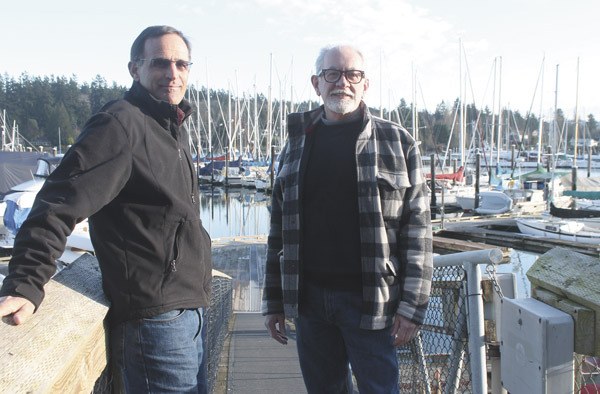The Quartermaster Yacht Club’s docks have long been a labor of love. The small, nonprofit club built its first docks in Burton by hand decades ago, added onto them as club numbers grew and in recent years have painstakingly maintained and repaired the aging, 100-slip structure.
But recently, faced with a set of rapidly deteriorating docks that are increasingly difficult and costly to patch together, the club decided to take an unprecedented move. It plans to install a new, state-of-the-art and environmentally friendly dock system as soon as this fall.
The $2 million project will cause yacht club rates to increase significantly, but club leaders say installing new docks in inner Quartermaster is not only in the club’s best interest — it’s the responsible thing to do.
“The club is very concerned with the environment,” said Commodore Dennis Williams. “We love the water. We’re all boaters of various types, and we’re very excited to do something good for the harbor.”
Buzz Blick, the club’s rear commodore, agreed.
“It made more sense economically and environmentally to replace it all at one time rather than do it piecemeal,” he said.
Yacht club members voted overwhelmingly to approve the project last fall, choosing new docks over a less expensive partial rebuild of the current structure. A rebuild would have lengthened the docks’ lives, but wouldn’t have included improvements to make them more environmentally friendly, Williams said.
The club is technically not required to make environmental upgrades for another 16 years, when the docks’ aquatic lease with the state is set to expire. But with encouragement from the state Department of Natural Resources (DNR), members opted to take the plunge sooner than later.
“It would be less expensive and faster to rebuild what we had, … but the members really stepped up and said we want to do the right thing,” Williams said.
Doing the right thing will come at a cost to the yacht club’s 167 members. To cover the $2 million project, moorage rates will more than double, increasing from the current rate of $1.50 per foot of boat length per month to about $3.50 per foot per month. Annual member dues will also increase slightly.
Williams called the fee increases significant, but said dues will still be more affordable than slip rental or club membership at other harbors in the area. The Quartermaster Marina charges around $9 per foot per month for annual moorage, and more for seasonal moorage, according to its website.
“We’ll still be at maybe a third of what the market rate is,” Williams said. “The club culture is to keep costs low and be as inclusive as possible.”
With a dock design now completed and financing secured, the club is currently waiting on permit approvals from multiple state and county agencies, with hopes of seeing the new docks on the water as soon as this fall.
The yacht club’s current docks, situated down a long stairway just north of the Quartermaster Marina, were built by members 40 years ago, and over time several pieces have been added on to make room for more boats. The most recent expansion, Williams said, is at least two decades old, and pieces of the structure are rapidly deteriorating, requiring constant repairs, all completed by members.
“Over the years we’ve done all our own work,” said Williams, who called the nonprofit club more of a boating co-op than a traditional yacht club.
But about a year ago, Williams said, the club realized the structure would need significant work to stay afloat. Working with DNR, which manages the harbor as part of the Maury Island Aquatic Reserve, members ultimately decided to install a new dock system that will hold the same number of boats but will be built with non-toxic materials and have a minimal impact on the underwater environment.
Creosote pilings and deteriorating styrofoam floats will be removed from the water, and the new docks will have fewer pilings, all made of steel. The structure will have a smaller surface area and penetrable walkways that will allow more sunlight to reach the floor of the harbor, considered better for the environment. And the docks will be situated farther from the shore, preventing the shallowest boats and floats from dragging the surface during low tides.
“It will be able to accommodate the boats more efficiently with less square footage of dock coverage,” Williams said.
The yacht club’s project coincides with a current DNR plan to clean up Quartermaster Harbor. Over the past year, the agency has been crafting a plan to remove abandoned buoys in the bay and has already removed or taken steps to remove several abandoned or sunken vessels, all in hopes of making the harbor safer for boaters and the environment.
Lisa Randlette, an environmental planner with DNR’s Aquatics Resources Division, praised the yacht club for choosing to make the environmental upgrades before it was required to. She noted that the Quartermaster Marina also brought its structure up to environmental standards when it recently completed a dock expansion, and the county plans to eventually make similar upgrades to the docks at Dockton Park.
“We’re appreciative (yacht club members) are stepping up and doing that now instead of leaving it to get more worn, and from an environmental impact perspective, it means there will be less impact in the near term,” she said.
The project will likely be up for public comment this year under a State Environmental Policy Act (SEPA) review.



